Question(: hey,
Im planning on breeding my panda bear hamster and my friends teddy bear hamster. Is it safe? They are differant breeds of hamsters, I know but they are both Syrian hamsters. I know never to breed a russian and a syrian of course! But I heard Teddy bear hamsters and Panda bear hamsters are very close in species so would it be okay to breed them? Also I'm new to breeding hamsters, my mom has done it many times before but I still would like some information. Would it be safe to keep one or two of the babies if they are both the same gender in the same cage? Please tell me EVERY THING you know about breeding hamsters and there babies and keeping them. And if there are any web sites you suggest please let me know! Thanks :)
AnswerHi Madie
Mating a panda bear hamster with a teddy bear isn't a problem as such as they are both Syrian. However there are quite a few things to consider before mating Syrians. Firstly, what is your reason for mating them? It is important to remember that Syrians can produce litters of up to 14 babies (I heard recently of one having 20!). At 4 weeks they will need separating and at 5-6 weeks they will all need a cage of their own. Therefore if you do find yourself with a large litter and they all survive are you going to be able to find enough homes for them and/or cages in the short term whilst you are waiting to re-home them?
If you just want to look after a litter, then it would probably be worth contacting a local pet rescue centre and asking them if you can foster a litter for them. I do this for a friend's rescue and it is great fun and at 4 weeks I hand the litter back to them for re-homing. This way I get to enjoy the babies but not have the stress of finding homes for them. Also it is worth considering that there are a lot of unwanted hamsters around (I don't know what the situation is where you live) and therefore it can be hard to find homes for them.
It is also important to consider the age of the hamster. Ideally the female should be around 3 -6 months old and in really good health.
Females come into season every 4 days. The best way I have found to mate them is to place the female on top of the male's cage in the evening. Never put her in with him or him with her as they will fight and sometimes it can be very serious. Once she is walking over his cage and he sniffs her, gently scratch her back. If she is in season then more often than not she will go rigid and arch her rear end. If she doesn't do this then try again the following evening and continue doing this each evening until you find the time she is in season. They only come into season for a matter of hours so you might want to try again later the same night.
If she does respond to him then you need to get a container (I use a dry washing up bowl) and place them both in this. It must be neutral territory that neither have been in before. Watch them all the time (it is worth having a container closeby so that you can place it over one of them in an emergency as if they fight it may be difficult to separate them). Do not let them come face to face - make sure the male stays behind the female. He should mount her, and afterwards (can be a matter of seconds/minutes) she usually washes herself if they have mated. At this stage separate them. The male plays no part in raising the litter so do not be tempted to put in back in with her or any babies as he will kill them.
It is then a case of waiting 16-18 days in case she is pregnant. If she is then during this time she will increase her water intake, perhaps move her nest and be busy storing food. Close to the expected date of a litter, clean her cage out but make sure that she has her nest and food returned to her if it is clean. I never clean out a pregnant hamster once the litter is born until they are 2-3 weeks old. When they are 3 weeks old you will need to clean them out daily, but again, I try not to throw out their nest unless necessary as it is less stressful if they have a familiar smell in their cage. Do not over-feed her while you are waiting to see if she has a litter - just give the usual amount of hamster food. If she is pregnant about 2 or 3 days prior to giving birth you will notice a bulge on her hips - this is especially obvious if she stretches up the bars of the cage. Usually the female is very active prior to giving birth.
Before the due date remove any plastic houses/tubes from the cage. You do not want the babies being born in a confined area - it is much less stressful all round if they are born in the open or under a platform. Also, if she has a wheel with bars or a drainage slit remove this. You will need to put in several wheels for the babies depending on the litter size - mum will need a large full sized solid wheel and the babies will be OK with the smaller solid ones. I usually fit as many wheels as possible in the cage - it is very noisy if they are all squeeking together.
Regarding bedding - I don't know what type you use, but if it is is the fluffy type do not use this. Hamsters (and babies especially) can get their legs caught up in this so it is safest to use the shredded paper type.
The birthing process is usually straightforward and everything goes well, but it is worth considering that sometimes things go wrong - she may die, along with the litter. Or she may give birth and develop mastitis and be unable to feed her young, or she can reject/kill her babies. Sorry to paint a black picture but it is important that pregnancy will put her at risk - hence another reason for giving serious consideration as to why you want to mate her. If in any doubt do not do it.
Assuming all goes well she will stay with her young a lot during the first couple of weeks. Every time she leaves the nest she should tuck them in. Do not be tempted to open up the nest to have a look. At this young age they can die quickly if their body temperature drops and therefore if you see any babies out in the open during this time it is vital you warm them in your hands and return them to the nest. If you have to do this then gently place your hands on the bedding, on her and on her other babies so that your scent is everywhere as this will hopefully stop her from attacking the baby. Handling the babies at this young age should be done in an emergency only as sometimes the mum leaves the nest with them still feeding and can leave a trail of them. More often than not she will gather them up. At this time you should increase her food - give her some human baby food. I buy a packet of the dry baby powder (creamy porridge oats) and mix a little with water. If you give this on a low dish daily and
when the babies are 2 weeks old they can eat this too if you put it in a low enough dish (I usually use a jam jar lid). Also drop food close to the nest for her and make sure she has a good supply of everything (dry hamster mix, fresh vegetables - don't give lettuce as this can cause diarrhoea). You can also put in raw porridge oats and bread as she will take this into the nest for her babies to eat.
At about 2 weeks the babies will start leaving the nest and from this age you can start handling them - be careful not to take them away from mum for more than a minute or two. Also make a fuss of her so that she doesn't stress. If there are a lot of babies sometimes it is easier to transfer them all into a carry case then handle them one at a time before returning them to their cage. This way you make sure they all get the same amount of handling time. They are very jumpy in the early days and it is safest to sit down to handle them as they can 'ping' out of your hands. The more they are handled, the tamer they will be.
During this time they will eat the same food as mum - you can also give small pieces of cheese or scrambled egg.
Make sure the babies can reach the water bottle - if necessary place a second bottle in the cage and build up a slope to it with wood chip.
At 4 weeks they need sexing and the boys taking out. The girls can remain with mum providing she is OK with them - if the litter is large then I usually take mum out at this stage because she will be tired and fed up with the babies. At 5 - 6 weeks they will start fighting and will all need separating into a cage of their own. This is when they can be re-homed.
As mentioned earlier this is an important decision to make - not only in the mating process as it can be risky for both of the hamsters (especially if you put them together and the female isn't in season) and so both you and your friend need to be happy with the situation before going ahead with it. Sometimes the female falls pregnant but miscarries/reabsorbs the litter. Also consider the possible size of a litter.
I hope this helps you decide what to do.
Regards
Sheila

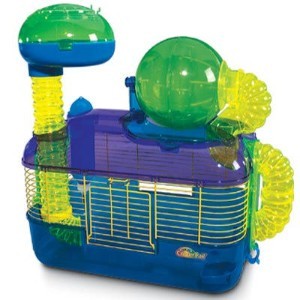 unexpected baby gerbils
Question
Cage
hello! I bought these gerbils 6 months ag
unexpected baby gerbils
Question
Cage
hello! I bought these gerbils 6 months ag
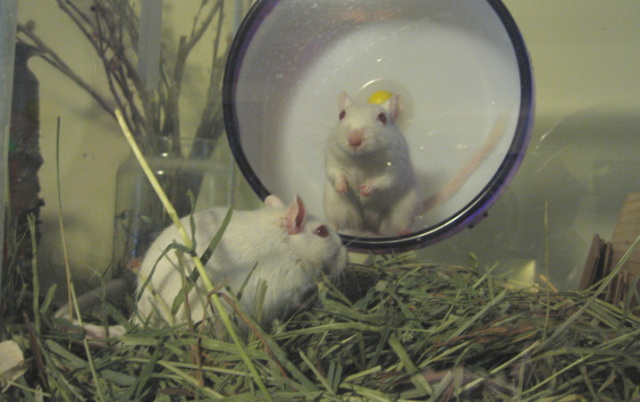 Companion for gerbil left?
Question
My girls
Hi Sheila! We purchased
Companion for gerbil left?
Question
My girls
Hi Sheila! We purchased
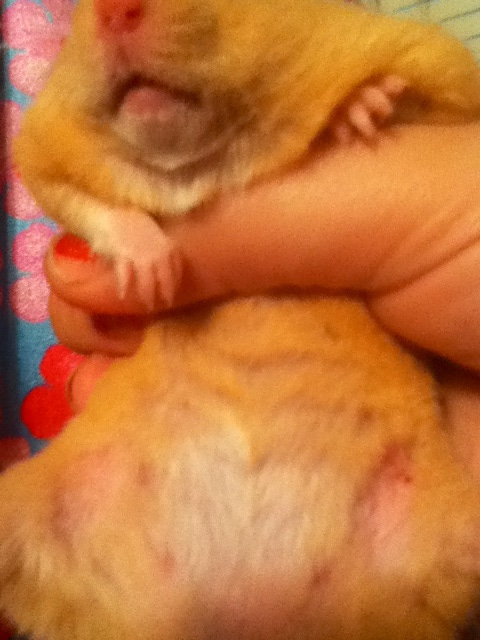 Hamster dry skin patches
Question
Hamster spots hamster spots 2
Hel
Hamster dry skin patches
Question
Hamster spots hamster spots 2
Hel
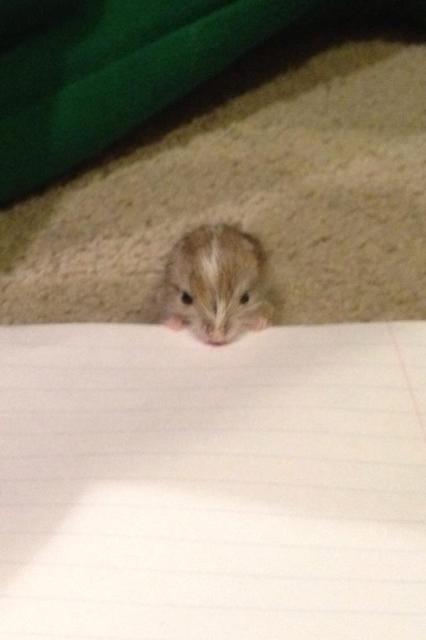 orphaned gerbil =(
QuestionQUESTION: Hi Sheila,
My daughters English class
orphaned gerbil =(
QuestionQUESTION: Hi Sheila,
My daughters English class
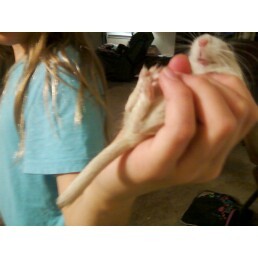 Help my gerbil!
QuestionMy gerbils tail
QUESTION: Hello,
Help my gerbil!
QuestionMy gerbils tail
QUESTION: Hello,